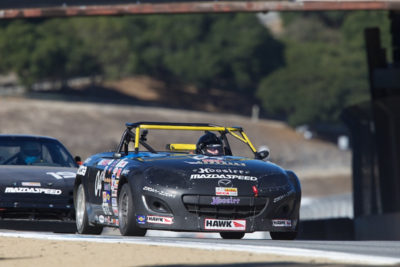Jonathan Goodale’s 12A-powered GT-Lite MX-5 carried him to a podium finish at the SCCA National Championship Runoffs.
One of the great things about SCCA’s Grand Touring classes, more commonly known as GT, is the versatility. With tube frame chassis covered by fiberglass, aluminum or carbon fiber body panels, the cars can be chameleons – one kind of car one day, a different one a short time later.
Jonathan Goodale’s GT-Lite MX-5 is one example. It started out as another make, a sedan; Goodale originally intended to make it into a Mazda MX-3. However, it ended up as a 12A rotary-powered NC MX-5 instead.
“I had a Suzuki Swift that I was running in GTL and they announced the Runoffs was going to Road America,” Goodale, a deputy sheriff in Colorado, says. “I thought, ‘This is not the car to go to Road America.’ I talked to Tim Buck [then Motorsports Specialist at Mazda] and asked him what he envisioned as being good for GT-Lite. He said, ‘If you want to do it cheap, build an RX-7. If you want to win, build a Miata.’ I thought, ‘OK, I can work with that.’”
He originally envisioned building the MX-3 – he knew body molds existed because someone had been running one in GT-3 – until Buck convinced him to build something more current. According to Goodale, Buck told him what he needed, and Goodale replied with, “Here’s my credit card. Send it.”
Goodale picked up the chassis that included brakes, suspension and running gear but no body or engine and built it during 2009, giving the car its debut at the Runoffs at Road America that year. He had Tony Rivera build him an engine, left Colorado with the car and took it to Texas to put the engine in, tuned it, then headed for Elkhart Lake.
“I was talking to [F Production Miata racer] Eric Prill after my first session and said, ‘My God…I came out of the pits, ran up through a couple of gears and turned into Turn 1 and the car just turned and went.’ He said, ‘Yeah, that’s what it’s like to drive a proper racecar.’”
If it was a better car for Road America, it was certainly the right car for Mazda Raceway Laguna Seca, host to the Runoffs this year. In his first visit to the track, Goodale finished third behind a couple of locals, including now-nine-time National Champion Joe Huffaker Jr.
“I was very happy for where I ended up. I don’t necessarily have a huge budget. I count on my friends and family to help me out here and there because I’m not only the driver, I’m the truck driver, I have to set up the car, set up the pit stall, cook breakfast…I couldn’t have done it without friends and family,” he says.
While rotary power might seem an odd choice for an MX-5 body, the GT classes are funny that way. Choose a body style, choose an engine from the same manufacturer. The engine, more than anything, determines the class. The rotary power has proven reliable and consistent for Goodale, who says he dyno’d the engine Rivera built for him in 2009 before the beginning of the 2014 season and found it was down only 2hp from where it started.
“I’m a fabricator, not an engine guy by any stretch of the imagination. So having Tony in my corner helped with that. He builds rotaries to run at 10,000RPM; this one makes max power at 6900RPM. A good E Production motor is making more horsepower, but running at 10,000RPM, it needs to be refreshed far more often,” says Goodale.
Even with an engine that’s still solid, Goodale is looking to make some changes for next year. Rivera says he can get more power out of the engine. Goodale is still running factory bodywork everywhere except the doors, which are skins rather than complete doors. He’d like to do new front and rear quarter panels, more to make the wheel wells better fit the 13-inch wheels he’s running than anything else. He’d also like to add a Speedway quick-change rear end to give him the ability to tune his gearing a little better because he’s running the Mazda EMCO close-ratio gearbox that doesn’t allow him to change gearing.
As he looks toward the 2015 Runoffs at Daytona, he’s considering whether to go open or closed.
“I need to do a little aero work for next year,” he explains. “I’ve run the car as both an open car and a closed car – I’ve got a windshield and top for it. I’m still kind of undecided on what’s best for Daytona, whether I go for the aero of having a windshield and roof, or the dirtier aero but less frontal area of having a roadster.”


 ACCESSIBILITY
ACCESSIBILITY